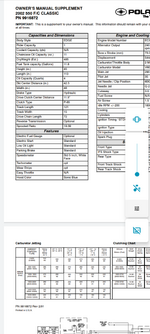J
I bought this 2002 Polaris Trail Touring off a friend who moved away. He bought it as a parts sled for his 550 fan, and I bought it from him as a fixer upper to learn how to work on snowmobiles.
I have rebuilt the chaincase, replaced the throttle cable, replaced the gaskets on the top end and have rebuilt the carbs. New spark plugs are also in there.
It moves...kinda.
I believe I have the throttle and idle adjusted pretty well. It idles, and once it warms up it idles around 2000 rpm.
On the stand, the sled will go wide open and seemingly through the full range of rpms. The belt moves, the primary clutch tightens, the secondary rotates. Sorta rewarding since this is my first kick at the snowmobile game.
Problem is, when I go to drive the sled, it will only move forward in a sweet spot at the 4200 rpm range - it'll go along at about 10-15 mph as long as I keep the throttle in the sweet spot. Attempting to open the throttle more than that results in the sled bogging down to a solid 3000 rpm. If I open the throttle fully when the sled is on the ground, it will just chug at 3000 rpm and the sled won't move.
It reverses, and the same stuff happens in reverse.
So I feel like I'm like 80% of the way to having a fully functioning bargain basement sled.
It actually starts pretty well, too. The issue is that it has absolutely no power and it will only move in a super narrow rpm band.
Any thoughts? Please bear in mind that almost nothing can really be overlooked- I wouldn't say I know what I'm doing with snowmobiles.
Other wildcard issues (which could matter for the key issue above?):
-fuel lines should be changed out
-sled only idles with kill switch unplugged
-spark only occurs when starting if throttle is slightly open, unless kill switch is unplugged
-belt deflection is about 1 inch, I really do think I have it set right- the plate on the secondary is set to 4 for a new belt
- I overlooked doing the crankcase seal
- I haven't touched the air screw on the carb to adjust idle
- carbs were synched with a 7/32 drill bit
I have rebuilt the chaincase, replaced the throttle cable, replaced the gaskets on the top end and have rebuilt the carbs. New spark plugs are also in there.
It moves...kinda.
I believe I have the throttle and idle adjusted pretty well. It idles, and once it warms up it idles around 2000 rpm.
On the stand, the sled will go wide open and seemingly through the full range of rpms. The belt moves, the primary clutch tightens, the secondary rotates. Sorta rewarding since this is my first kick at the snowmobile game.
Problem is, when I go to drive the sled, it will only move forward in a sweet spot at the 4200 rpm range - it'll go along at about 10-15 mph as long as I keep the throttle in the sweet spot. Attempting to open the throttle more than that results in the sled bogging down to a solid 3000 rpm. If I open the throttle fully when the sled is on the ground, it will just chug at 3000 rpm and the sled won't move.
It reverses, and the same stuff happens in reverse.
So I feel like I'm like 80% of the way to having a fully functioning bargain basement sled.
It actually starts pretty well, too. The issue is that it has absolutely no power and it will only move in a super narrow rpm band.
Any thoughts? Please bear in mind that almost nothing can really be overlooked- I wouldn't say I know what I'm doing with snowmobiles.
Other wildcard issues (which could matter for the key issue above?):
-fuel lines should be changed out
-sled only idles with kill switch unplugged
-spark only occurs when starting if throttle is slightly open, unless kill switch is unplugged
-belt deflection is about 1 inch, I really do think I have it set right- the plate on the secondary is set to 4 for a new belt
- I overlooked doing the crankcase seal
- I haven't touched the air screw on the carb to adjust idle
- carbs were synched with a 7/32 drill bit



